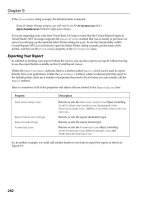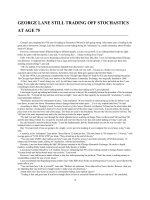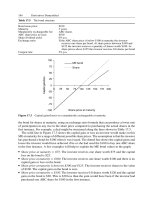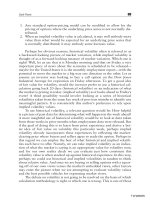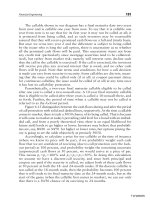STUDY GUIDE FOR COME INTO MY TRADING ROOM phần 9 docx
Bạn đang xem bản rút gọn của tài liệu. Xem và tải ngay bản đầy đủ của tài liệu tại đây (236.88 KB, 20 trang )
Trade 4: Imclone Systems IMCL—Entry Question
QUESTIONS 153
Imclone is a biopharmaceutical company, working on cancer treatments.
Answer on pages 176–177.
Chart Q4-a 26-week and 13-week EMAs, 12-26-9 MACD-lines and MACD-
Histogram
Chart Q4-b 22-day and 13-day EMAs, 12-26-9 MACD-lines and MACD-
Histogram, 2-day Force Index
Cover this chart with a sheet of paper and move it slowly from left to
right, one day at a time. Mark entry and exit points and jot down a com-
ment about each. Later, on the Answers pages, we will review them,
and you’ll earn points for each correctly identified exit or reentry point.
We went long IMCL in the area marked by an arrow in August. Chart
patterns and indicator signals can help us decide where to take profits
and where to reestablish longs. When you look at an old chart, the
benefit of hindsight makes it seem very easy to hold for the long haul.
If you cover up the chart and advance one day at a time, you will recre-
ate some of the uncertainty and the psychological pressures of trading;
taking short-term profits will suddenly look a lot more appealing.
154 CASE STUDIES
Trade 4: Imclone Systems IMCL—Exit Question
entry
long
Chart Q4-c 22-day and 13-day EMAs, channel, 12-26-9 MACD-lines and
MACD-Histogram, 2-day Force Index
Answer on pages 178–179.
Trade 5: Wheat—Entry Question
QUESTIONS 155
The rules of technical analysis work in any freely traded market, including
stocks, futures, and currencies—it can be applied to most trading vehicles.
Many popular technical tools were originally developed for commodities
and only later migrated to the stock market.
Answer on pages 180–181.
Chart Q5-a
Chart Q5-b
Trade 5: Wheat—Exit Question
156 CASE STUDIES
entry
long
Chart Q5-c 22-day and 13-day EMAs, channel, 12-26-9 MACD-lines and
MACD-Histogram, 2-day Force Index
The best way to test a trading system is by clicking through your data
one day at a time. To learn from a chart, cover it with a sheet of paper,
moving it from left to right, a day at a time. Mark all entry and exit points
and jot down a comment about each. Later, on the Answers pages, you’ll
earn points for each correctly identified exit or reentry point.
We went long wheat in the area marked by an arrow in October. Use
chart patterns and indicator signals to decide where to take profits and to
reestablish longs. If you cover up the chart and advance one day at a time,
you will recreate some of the uncertainties and pressures of trading.
Answer on pages 182–183.
Trade 6: Vimpel Communications VIP—Entry Question
QUESTIONS 157
Mark at least two trading signals on the weekly and daily charts. Answer on pages 184–185.
Here’s another set of charts that reflects the universality of technical
analysis. The charts show a Russian stock listed on the NYSE—a cell
phone company from Moscow. I sometimes think that when we trade
VIP, comrades Lenin and Stalin take a few spins in their graves.
Chart Q6-a
Chart Q6-b
Trade 6: Vimpel Communications VIP—Exit Question
158 CASE STUDIES
entry
long
Chart Q6-c 22-day and 13-day EMAs, channel, 12-26-9 MACD-lines and
MACD-Histogram, 2-day Force Index
Cover this chart with a sheet of paper and move it, one bar a time, from
left to right. Mark all entry and exit points and jot down a comment
about each. Once finished, review the Answers pages and award your-
self points for each correctly identified exit or reentry point.
We went long VIP near the fast EMA, in the area marked by an arrow
in October. Use chart patterns and indicator signals to decide where
to take profits and where to reestablish longs. Covering up the chart
and opening it up one day at a time allows you to recreate some of the
pressure of trading this seemingly exotic stock.
Answer on pages 186–187.
Trade 7: International Business Machines IBM—Entry Question
QUESTIONS 159
Mark at least two trading signals on the weekly as well as the daily charts and make a
trading decision at the right edge.
Answer on pages 188–189.
IBM, “Big Blue”, is widely held by institutions. It is a charter member of
the blue chip club. It can swing, but it is unlikely to embark on a wild
rally or suffer a bone-crashing decline like so many “cats and dogs.”
Chart Q7-a
Chart Q7-b
Trade 7: International Business Machines IBM—Exit Question
160 CASE STUDIES
entry
long
Chart Q7-c 22-day and 13-day EMAs, channel, 12-26-9 MACD-lines and
MACD-Histogram, 2-day Force Index
Cover this chart with a sheet of paper and move it one bar at a time,
from left to right. Identify entries, exits, and reentry points. Mark each
of them and write a brief comment. Do not go to the Answers pages
until you have finished this work.
We went long IBM near the fast EMA, in the area marked by an arrow
in October. Keep tracking IBM one day at a time and find where to take
profits and where to reestablish longs in this blue chip.
Answer on pages 190–191.
Trade 8: Biovail Corporation BVF—Entry Question
QUESTIONS 161
Mark at least two trading signals on the weekly as well as the daily charts and make a
trading decision at the right edge. Do not turn this page or look at the Answers pages
until you have documented your decision.
Answer on pages 192–193.
Chart Q8-a 26-week and 13-week EMAs, 12-26-9 MACD-lines and MACD-
Histogram
Chart Q8-b 22-day and 13-day EMAs, 12-26-9 MACD-lines and MACD-
Histogram, 2-day Force Index
Trade 8: Biovail Corporation BVF—Exit Question
162 CASE STUDIES
entry
long
Chart Q8-c 22-day and 13-day EMAs, channel, 12-26-9 MACD-lines and
MACD-Histogram, 2-day Force Index
Follow the usual pattern of covering this chart with a sheet of paper and
moving it, one bar at a time, from left to right. After each new bar
opens up, try to identify entries, exits, and reentry points. Mark each of
them, write a brief comment, and when you finish working through the
entire chart go to the Answers pages.
We went long BVF when it was straddling its EMAs, in the area
marked by an arrow in September. Keep tracking BVF one day at a time
and find where to take profits or reestablish longs.
Answer on pages 194–195.
SECTION
FOUR
LET’S TRADE:
ANSWERS
AND RATINGS
164 CASE STUDIES
Trade 1: Oracle Corp ORCL—Entry Answer
A Fallen Angel Ready to Fly
A
C
B
Chart A1-a
When the bull market in technology stocks ended in 2000, it gave way
to a vicious bear market. Many weak companies were delisted and went
bankrupt, but the decline also swept down shares of many well-run com-
panies. Oracle is one of America’s great technological corporations, not
some silly dot-com. Still, its shares were taken down from a high of 46
in 2000 to a low of 10 in 2001, a nearly 80% decline.
In early October 2001, weekly MACD-Histogram ticked up from a
higher bottom, completing a bullish divergence against a much lower
bottom in May, while prices traced a lower bottom. The fast 13-week
EMA turned flat. Even though the longer-term 26-week EMA continued
to decline, a bullish divergence of MACD-Histogram allowed us to
override the signal of the EMA.
The daily chart sports two bullish divergences. MACD-Histogram
keeps tracing more and more shallow bottoms, which show that bears
are becoming weaker even as prices grind lower. The more shallow bot-
toms of Force Index confirm that bears are running out of steam.
The blank area in September marks the week when the market was
closed, following the September 11th disaster. After the market reopened,
ANSWERS 165
many stocks went into a tailspin, but ORCL just flirted with the new lows
for a few days before rallying. During that rally, Force Index rose to its
highest peak since June, confirming that this stock was completely sold
out, bears had no more power, and the next move was likely to be up.
Entry Ratings
W
EEKLY CHART
A—Bullish divergence of MACD-Histogram: 1 point
B—Bullish divergence of MACD-lines: 1 point
C—Price below the EMA, in the undervalued zone: 1 point
D
AILY CHART
A—Bullish divergence of MACD-Histogram: 1 point
B—Bullish divergence of Force Index: 1 point
C—Rising 13-day EMA, price in the value zone between fast and
slow EMAs: 1 point
D
ECISION
Go long ORCL, with a stop below the month’s low, and observe
money management rules: 3 points.
P
ASS POINT 6
C
B
A
Chart A1-b
166 CASE STUDIES
Trade 1: Oracle Corp ORCL—Exit Answer
ORCL wasted little time before rallying above its moving averages. The
failure of the rally to reach the upper channel line lets you know that
the upmove is not likely to be very strong. The channel has been drawn
to contain the data during the decline in September. Back then, declines
used to punch the lower channel line. Now, the failure of prices to
reach the upper channel line shows that the rally is weak and profits
should be taken quickly instead of waiting for more, which you would
do in a powerful rally.
At point A, Force Index has completed a triple bearish divergence—
three lower tops during three uplegs of a rally. Prices still cannot reach
the upper channel line, making this a good spot to take profits and
employ your cash and attention elsewhere. The divergence deepens
at point B and gives a final ring at point C, after Force Index rises
above its centerline following the first nasty spill since the beginning of
the rally.
Overstaying a long trade in area C would have meant sitting through
an unpleasant decline below the EMA. That decline D actually creates
AB
C
DE
F
entry
long
Chart A1-c
another buying opportunity, followed by a bearish divergence of
MACD-Histogram in area E—a lower indicator peak during a higher
price peak.
A trader who oversleeps exit E gets one last chance in area F, where
the EMAs scream to sell when they turn down. Holding longs beyond
that point is strictly for losers.
Exit Ratings
D
AILY CHART A-1C
Sell longs in area A: 3 points
Sell longs in area B: 2 points
Sell longs in area C: 2 points
Reposition long in area D: 2 points
Sell longs in area E: 3 points
Sell longs in area F: 1 point
P
ASS POINT 7
Why do some casinos give players bonuses for spending more time
at the tables? They know that the longer you stay, the more likely you
are to leave your money in the casino. The best trades are fairly short.
You identify an island of order in the ocean of disorder, put on a trade
to capitalize on it, quickly pocket your winnings, and go looking for
another trade. There is no ideal exit, but generally, a fast exit is better
than a slow one.
ANSWERS 167
168 CASE STUDIES
Trade 2: Sun Microsystems SUNW—Entry Answer
Sold Down to Rock Bottom
A
B
C
Chart A2-a
This is another “fallen angel”—a high flier blown out of the sky by the
bear market in high-tech stocks. Many poor souls were desperate enough
to buy SUNW at 65, but few buyers came when SUNW hit its 7.50 low.
The average height of a bar reflects the level of trading activity. The bars
were much taller above 60 than below 10, reflecting greater public
interest in this stock near the top than near the bottom.
At the right edge of the weekly chart, MACD-Histogram has com-
pleted a bullish divergence A by ticking up from a much more shallow
bottom in 2001 than it reached in 2000, even though prices are much
lower. Moreover, there is a rarely seen bullish divergence B of MACD-
lines between the April and September bottoms. In area C, prices are
undervalued, below the EMA, and the latest bar of MACD-Histogram,
while pointing down, is shorter than the previous bar. This uptick com-
pletes a bullish divergence, telling us to look for an entry into a long
trade on the daily charts.
The daily chart shows a bullish divergence A between Force Index
and price, reflecting the weakness of bears during the late September
ANSWERS 169
low. In area B, both MACD-Histogram and MACD-lines are rising, con-
firming the strength of the bulls. At the right edge of the chart, in area
C, the fast EMA is already rising, a bullish sign. The slow EMA is still flat,
with prices in the value area between the two EMAs.
Entry Ratings
W
EEKLY CHART
A—Bullish divergence of MACD-Histogram: 1 point
B—Bullish divergence of MACD-lines: 1 point
C—Price below the EMA, in the undervalued zone: 1 point
D
AILY CHART
A—Bullish divergence of Force Index: 1 point
B—Rising MACD-Histogram and MACD-lines: 1 point
C—Rising 13-day EMA, price in the value zone between fast and
slow EMAs: 1 point
D
ECISION
Go long SUNW, with a stop below the month’s low, and observe
money management rules: 3 points.
P
ASS POINT 6
A
B
C
Chart A2-b
Trade 2: Sun Microsystems SUNW—Exit Answer
170 CASE STUDIES
As a rule, it pays to bracket the long moving average with an envelope
or a channel and use its walls as guidelines for taking profits. One of the
few proven behaviors of the market is its tendency to oscillate above
and below value. If we buy near the moving average, near value, then
our goal is to sell when the stock or commodity becomes overvalued,
near the upper channel line.
The first selling opportunity in SUNW comes in area A, after the stock
spends more than a week going nowhere, straddling its moving average.
Do we want to give the trade more time to work out, or close it and look
for another? If you trade a small account, it is important to free up your
capital. Even in a larger account, a stock that is going nowhere ties up
more than capital. It competes for the trader’s attention, taking his mind
off other, more promising, trades, almost like a sick child tends to get
the lion’s share of attention in the family.
If we continue to hold, SUNW presents a fantastic selling opportu-
nity in area B. Prices speed up to the upside, puncture the upper chan-
nel line with an unusually tall bar, only to weaken near the close and
end the day within the channel. Our goal is to sell above value, and this
A
BCD
entry
long
Chart A2-c
stab above the upper channel line shows that the market is overvalued
but cannot hold that level. MACD-Histogram ticks down the next day,
confirming that bulls are running out of breath.
A quick stab into the area between the two EMAs around Thanks-
giving, in area C, creates a buying opportunity since the weekly chart
still is in an uptrend. In area D, SUNW rises to a double top, while
MACD-Histogram traces a bearish divergence and gives a strong sell
signal. Prices fail to reach their upper channel line, while MACD-
Histogram diverges and even MACD-lines start to diverge. There is no
point in sticking around any longer; it is high time to take your winnings
off the table and switch your attention to another stock.
Exit Ratings
D
AILY CHART A-2C
Sell longs in area A: 3 points
Sell longs in area B: 5 points
Reposition long in area C: 3 points
Sell longs in area D: 3 points
P
ASS POINT 8
ANSWERS 171
Trade 3: Kroll Inc KROL—Entry Answer
KROL—On the Front Burner
172 CASE STUDIES
This trade illustrates the importance of fundamental analysis and the
value of personal networking. Shortly after the September 11 disaster, a
group of campers gathered for our regular monthly meeting in my
Manhattan apartment. We agreed that the investment/trading theme
for the next several months was likely to be security and I asked one of
our campers to come up with a complete list of all security-related
firms. I reviewed each of them, using the Triple Screen system. KROL
appeared to be the most attractive stock on the list, and I e-mailed my
analysis to everyone who was at our meeting.
Kroll, Inc. is an international corporate security firm. Its stock traded
above 41 in 1999 before sliding below 5 in 2000 when it made a few
unwise acquisitions. In 2001 it appeared completely sold out and list-
less, with narrow weekly ranges. MACD-Histogram and MACD-lines
have traced bullish divergences A and B, while prices have traced a
rounded bottom, known as a “saucer bottom” C, with a breakout at D.
The daily chart shows an upside gap immediately after the resumption
of trading in September, followed by a brief pullback. The huge peak of
Force Index, which makes its entire previous history appear as a flat line,
shows a tremendous bullish force and calls for higher prices ahead. Both
B
A
C
D
Chart A3-a
